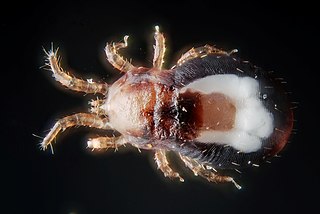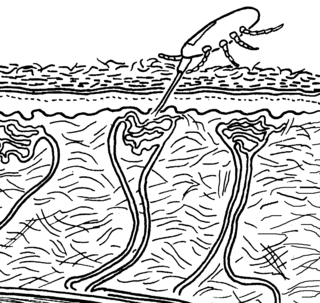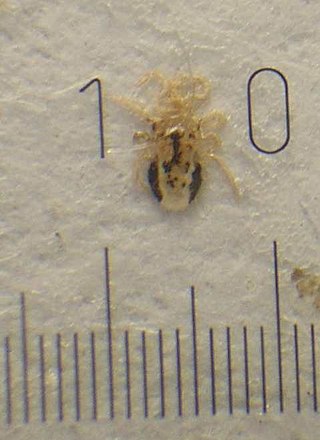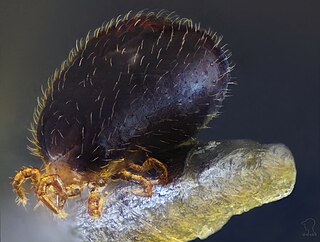
Rats are various medium-sized, long-tailed rodents. Species of rats are found throughout the order Rodentia, but stereotypical rats are found in the genus Rattus. Other rat genera include Neotoma, Bandicota and Dipodomys.

Flea, the common name for the order Siphonaptera, includes 2,500 species of small flightless insects that live as external parasites of mammals and birds. Fleas live by ingesting the blood of their hosts. Adult fleas grow to about 3 millimetres long, are usually brown, and have bodies that are "flattened" sideways or narrow, enabling them to move through their hosts' fur or feathers. They lack wings; their hind legs are extremely well adapted for jumping. Their claws keep them from being dislodged, and their mouthparts are adapted for piercing skin and sucking blood. They can leap 50 times their body length, a feat second only to jumps made by another group of insects, the superfamily of froghoppers. Flea larvae are worm-like, with no limbs; they have chewing mouthparts and feed on organic debris left on their hosts' skin.

Cimex lectularius is a species of Cimicidae. Its primary hosts are humans, and it is one of the world's major "nuisance pests".
Rat-bite fever (RBF) is an acute, febrile human illness caused by bacteria transmitted by rodents, in most cases, which is passed from rodent to human by the rodent's urine or mucous secretions. Alternative names for rat-bite fever include streptobacillary fever, streptobacillosis, spirillary fever, bogger, and epidemic arthritic erythema. It is a rare disease spread by infected rodents and caused by two specific types of bacteria:
- Streptobacillus moniliformis, the only reported bacteria that causes RBF in North America
- Spirillum minus, common in Asia. Most cases occur in Japan, but specific strains of the disease are present in the United States, Europe, Australia, and Africa.
Acariasis is an infestation with mites.

Ixodes holocyclus, commonly known as the Australian paralysis tick, is one of about 75 species in the Australian tick fauna and is considered the most medically important. It can cause paralysis by injecting neurotoxins into its host. It is usually found in a 20-kilometre wide band following the eastern coastline of Australia. Within this range Ixodes holocyclus is the tick most frequently encountered by humans and their pets. As this area also contains Australia's most densely populated regions, bites on people, pets and livestock are relatively common.

The Oriental rat flea, also known as the tropical rat flea or the rat flea, is a parasite of rodents, primarily of the genus Rattus, and is a primary vector for bubonic plague and murine typhus. This occurs when a flea that has fed on an infected rodent bites a human, although this flea can live on any warm blooded mammal.

The cat flea is an extremely common parasitic insect whose principal host is the domestic cat, although a high proportion of the fleas found on dogs also belong to this species. This is despite the widespread existence of a separate and well-established "dog" flea, Ctenocephalides canis. Cat fleas originated in Africa but can now be found globally. As humans began domesticating cats, the prevalence of the cat flea increased and it spread throughout the world.

Dermanyssus gallinae is a haematophagous ectoparasite of poultry. It has been implicated as a vector of several major pathogenic diseases. Despite its common names, it has a wide range of hosts including several species of wild birds and mammals, including humans, where the condition it causes is called gamasoidosis. In both size and appearance, it resembles the northern fowl mite, Ornithonyssus sylviarum.

Amblyomma americanum, also known as the lone star tick, the northeastern water tick, or the turkey tick, is a type of tick indigenous to much of the eastern United States and Mexico, that bites painlessly and commonly goes unnoticed, remaining attached to its host for as long as seven days until it is fully engorged with blood. It is a member of the phylum Arthropoda, class Arachnida. The adult lone star tick is sexually dimorphic, named for a silvery-white, star-shaped spot or "lone star" present near the center of the posterior portion of the adult female shield (scutum); adult males conversely have varied white streaks or spots around the margins of their shields.

The human flea – once also called the house flea – is a cosmopolitan flea species that has, in spite of the common name, a wide host spectrum. It is one of six species in the genus Pulex; the other five are all confined to the Nearctic and Neotropical realms. The species is thought to have originated in South America, where its original host may have been the guinea pig or peccary.

Trombiculidae, commonly referred to in North America as chiggers and in Britain as harvest mites, but also known as berry bugs, bush-mites, red bugs or scrub-itch mites, are a family of mites. Chiggers are often confused with jiggers – a type of flea. Several species of Trombiculidae in their larva stage bite their animal or human host and by embedding their mouthparts into the skin cause "intense irritation" or "a wheal, usually with severe itching and dermatitis".

Gamasoidosis, also known as dermanyssosis, is a frequently unrecognized form of dermatitis, following human infestation with avian mites of the genera Dermanyssus or Ornithonyssus. It is characterized by pruritic erythematous papules, macules and urticaria, with itching and irritation resulting from the saliva the mites secrete while feeding. These bites are commonly found around the neck and areas covered by clothing, but can be found elsewhere on the body. The avian mite Dermanyssus gallinae can also infest various body parts, including the ear canal and scalp.

Ornithonyssus is a mite genus of the family Macronyssidae.

Ophionyssus natricis, the reptile mite, is a parasitic mite most commonly found on snakes, but also occurring on captive lizards, turtles, crocodiles, and other reptiles. The parasites feed on snakes, which cause the bodies of the mites to be engorged with blood and fluids from the snake. Once the mites feed by puncturing through the snake skin, the snake usually shows symptoms of irritation and discomfort. The involvement of snake mites in transmission of infectious illnesses like inclusion body disease and ophidian paramyxovirus remains controversial. Human infestation has been reported.

Nosopsyllus fasciatus, the northern rat flea, is a species of flea found on domestic rats and house mice. Northern rat fleas are external parasites, living by hematophagy off the blood of rodents. N. fasciatus can bite humans, but they are more common parasites of rodents. Since they are associated with humans, they are common disease vectors that can spread from animals to humans. Diseases that can be spread through fleas include the plague and typhus. The rat flea is widespread due to their relationship to rodents and other vertebrates. They can be found co-infecting their host with other parasites.
Ornithonyssus bursa is a species of mite. It is most often a parasite of birds, but also has been found to bite humans and two species of mammals. It usually lives in birds' feathers, but for laying its eggs, it more often uses their nests rather than their feathers. Tropical fowl mites undergo five stages during their development: egg, larva, protonymph, deutonymph, and adult. During the last two stages, they suck blood from their host for food. They are often diurnal, whereas northern fowl mites are nocturnal in nature.

Mites that infest and parasitize domestic animals cause disease and loss of production. Mites are small invertebrates, most of which are free living but some are parasitic. Mites are similar to ticks and both comprise the order Acari in the phylum Arthropoda. Mites are highly varied and their classification is complex; a simple grouping is used in this introductory article. Vernacular terms to describe diseases caused by mites include scab, mange, and scabies. Mites and ticks have substantially different biology from, and are classed separately from, insects. Mites of domestic animals cause important types of skin disease, and some mites infest other organs. Diagnosis of mite infestations can be difficult because of the small size of most mites, but understanding how mites are adapted to feed within the structure of the skin is useful.

Mites are small crawling animals related to ticks and spiders. Most mites are free-living and harmless. Other mites are parasitic, and those that infest livestock animals cause many diseases that are widespread, reduce production and profit for farmers, and are expensive to control.
Rodent mite dermatitis is an often unrecognized ectoparasitosis occurring after human contact with haematophagous mesostigmatid mites that infest rodents, such as house mice, rats and hamsters. The condition is associated with the tropical rat mite, spiny rat mite and house mouse mite which opportunistically feed on humans. Rodent mites are capable of surviving for long periods without feeding and travelling long distances when seeking hosts. Cases have been reported in homes, libraries, hospitals and care homes. A similar condition, known as gamasoidosis, is caused by avian mites.
















